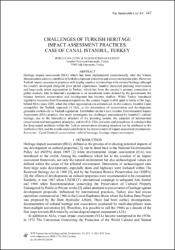| dc.contributor.author | Çetin, Burcu Can | en_US |
| dc.contributor.author | Gülersoy, Nuran Zeren | en_US |
| dc.date.accessioned | 2022-01-13T14:48:24Z | |
| dc.date.available | 2022-01-13T14:48:24Z | |
| dc.date.issued | 2021 | |
| dc.identifier.citation | Çetin, B. C. & Gülersoy, N. Z. (2021). Challenges of Turkish heritage impact assessment practices: case of canal Istanbul, Turkey. WIT Transactions on Ecology and the Environment, 253, 347-258. doi:10.2495/SC210291 | en_US |
| dc.identifier.issn | 1746-448X | |
| dc.identifier.uri | https://hdl.handle.net/11729/3372 | |
| dc.identifier.uri | http://dx.doi.org/10.2495/SC210291 | |
| dc.description | The ideal impact assessment process has twelve steps, six of which are part of the comprehensive impact assessment: description of the project, affected environment and alternatives; definition, prediction, assessment, and mitigation of impacts; production of impact assessment report; review of the impact report/study; consultation and participation; and final decision [43]–[45]. For the HIA, however, values of the affected cultural heritage site and significance assessment [1], as well as cultural, indigenous, and social assessments are prerequisites for a proper study [46]–[49]. Since the Turkish HIA system has not been established, HIA studies are conducted under EIA, in concordance with characteristics of development or features of an affected environment as being only “the world heritage”. Therefore, if development is applied for financial support from international institutions, the impact assessment team will follow the guidelines of the institution, and if the affected environment is listed as a world heritage, documents and suggestions by UNESCO and advisory bodies will be respected. | en_US |
| dc.description.abstract | Heritage impact assessment (HIA) which has been implemented internationally after the Vienna Memorandum aims to contribute to both development initiatives and conservation principles. However, Turkish impact assessment practices still display inactive relationships with cultural heritage although the country developed alongside prior global experiences. Istanbul pioneered planning interventions and large-scale urban regeneration in Turkey, which has been the country's primary connection to global markets. Due to Istanbul's reputation as an investment centre defined by the government, the balance between conservation and development has become shallow. While Turkey introduced legislative measures from European perspectives, the country began to drift apart in terms of the logic behind HIAs since 2005, when the urban regeneration era commenced. In this context, Istanbul Canal exemplifies the Turkish approach of HIA, at the intersection of conservation and development, grounded exclusively in Turkish legislation. Established on the Canal Istanbul Environmental Impact Assessment (EIA) practice, this study investigates the challenges encountered by Istanbul's cultural heritage, due to the hierarchical structure of the planning system, the adoption of international conservation and management principles, and the EIA-HIA processes and procedures. It considers that the deep-seated problems within the Turkish conservation-planning structure can be attributed to the ineffective HIA, and the results could contribute to the improvement of impact assessment mechanisms. | en_US |
| dc.language.iso | eng | en_US |
| dc.publisher | WITPress | en_US |
| dc.relation.isversionof | 10.2495/SC210291 | |
| dc.rights | info:eu-repo/semantics/openAccess | en_US |
| dc.subject | Canal Istanbul | en_US |
| dc.subject | Conservation | en_US |
| dc.subject | Cultural heritage | en_US |
| dc.subject | Heritage impact assessment | en_US |
| dc.subject | Intangible cultural heritage | en_US |
| dc.subject | UNESCO | en_US |
| dc.subject | World heritage | en_US |
| dc.title | Challenges of Turkish heritage impact assessment practices: case of canal Istanbul, Turkey | en_US |
| dc.type | article | en_US |
| dc.description.version | Publisher's Version | en_US |
| dc.relation.journal | WIT Transactions on Ecology and the Environment | en_US |
| dc.contributor.department | Işık Üniversitesi, Mimarlık ve Tasarım Fakültesi, Mimarlık Bölümü | en_US |
| dc.contributor.department | Işık University, Faculty of Architecture and Design, Department of Architecture | en_US |
| dc.contributor.authorID | 0000-0003-3268-7049 | |
| dc.identifier.volume | 253 | |
| dc.identifier.startpage | 347 | |
| dc.identifier.endpage | 358 | |
| dc.peerreviewed | Yes | en_US |
| dc.publicationstatus | Published | en_US |
| dc.relation.publicationcategory | Makale - Uluslararası Hakemli Dergi - Kurum Öğretim Elemanı | en_US |
| dc.contributor.institutionauthor | Gülersoy, Nuran Zeren | en_US |
| dc.relation.index | Scopus | en_US |



















